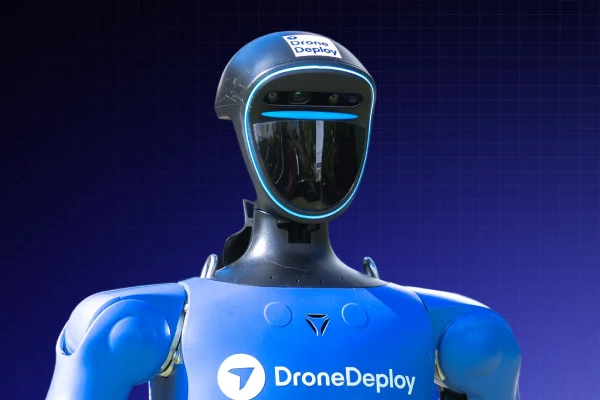Woodside transforms asset management with ground robots

Quick Summary
Woodside, Australia’s largest oil and gas production and exploration company, has collaborated with DroneDeploy to roll out an innovative robotics program – transforming their asset management system.
By sending ground robots to capture 360 degree and high-resolution photographs of assets and uploading this geolocated data to their digital twin, FUSE, Woodside is saving significant time and resources while reducing the time operators are in the line of fire.
Spector: An innovative robotics inspection solution
Spector is a data capture service that combines the latest robotics hardware and software technology with Woodside’s best operational practices. Spector captures data in extreme and hazardous environments, reducing risks to human operators and freeing them up for higher value tasks.
Woodside started exploring the value of robots by deploying them at the Woodside operated Pluto LNG Plant. The first use case for the robots was to capture the data necessary to perform Electrical Equipment in Hazardous Areas (EEHA) inspections. These inspections take place in industrial locations where there are increased hazards like noise, heat and moving equipment.
The visual inspections are time-consuming and mandated by regulations, but are not considered as high value as detailed inspections and repair work. It was the perfect opportunity to put robots to work. This is how Project Spector – short for ‘inspector’ – was born.
By using Spot (from Boston Dynamics) to capture data for EEHA inspections, inspectors spend less time traveling and looking for the equipment in the field. This gives them more time to analyze data so they can spot defects earlier, or carry out repairs, leading to a safer asset.

Partnering with DroneDeploy to maximize value
Getting robots to follow complicated routes and capture the right asset data is a complicated undertaking. Woodside partnered with DroneDeploy to accelerate their robotics program, and are now using DroneDeploy’s sophisticated robot mission planning system to delegate autonomous inspection missions to Spot.
Spot follows an auto-generated route and inspects assigned areas, taking high-resolution and 360 photographs of assets along with geolocation data. This information is automatically uploaded to the cloud and Woodside’s bespoke asset management system and digital twin platform, FUSE.
Woodside’s inspectors then use these images to complete regulatory visual inspections for electrical equipment under performance standards, and identify any issues before they become dangerous faults. Inspectors can also identify which repairs require specialized equipment and spare parts, leading to even more time savings by pre-planning repair scopes.
Safety considerations in hazardous environments
Of course, safety was another critical consideration when developing this solution. Typically, inspectors in these areas have a hot work permit and carry a personal gas monitor. They’re able to shut down equipment if a situation becomes hazardous.
To automate this function, Woodside worked with its internal engineering functions and external partners to integrate gas sensors into Spot itself. If the gas sensor detects elevated levels of gas in the area, it sends a signal to isolate the battery and power-down every component of the robot, allowing it to safely operate in classified areas.
Expanding the role of Spector
The initial trials with DroneDeploy’s Robotics platform have proven highly successful, and Woodside launched their Spector product in July of 2023.
Looking forward, Woodside is hoping to expand its use cases for Spector. For example, Spector could be used to verify gauge readings and fluid levels, listen for noise and vibration anomalies on pumps and compressors, and conduct thermal inspections for process equipment such as vents and refrigeration columns.
Woodside is also hoping to use robots to automate other inspection use cases – such as emergency lighting, corrosion detection, structural inspections, methane leak detection and more. It’s clear that visual inspections are just the beginning for this innovative robotics deployment.
Want to learn more about deploying robots for inspections? Watch the full webinar on-demand for expert advice from DroneDeploy, Boston Dynamics and Woodside.

FAQ
Related articles
Ready to manage your data from the very start?
Book a quick call to see how DroneDeploy streamlines capture from construction through building ROI.
.svg)
.png)


